Route 4
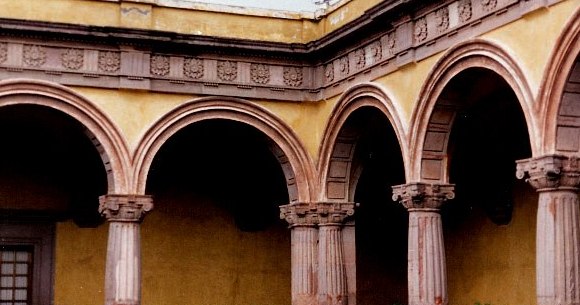
The Birthplace of History & Romantisim
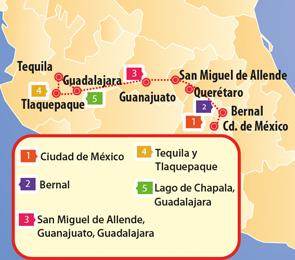 Mexico City
Mexico City
Everything comes together in this huge city, the oldest in the American continent: Colonial buildings, Pre-Hispanic vestiges, and the whirl of contemporary living. The variety of cultural spaces and heritage sites has given it a cosmopolitan nature. Neighborhoods – all different – offer bohemian, sophisticated, fun, and educational experiences, and more. And exploring the Centro Historico (downtown area), where everything began, is undoubtedly something you cannot miss. In the range of possibilities in Distrito Federal, there are also rural areas: capsules of peaceful green like those offered by tours around Xochimilco canals.
Mexico City has, until today, four designations as World Heritage Sites. In the Centro Historico – exemplary core of the City of Palaces – the opulent Colonial architecture rests over vestiges of the former Mexica metropolis. In Xochimilco, the fabulous original nature is conserved between channels and trajineras (traditional boats), like an American Venice. Ciudad Universitaria and Casa Estudio de Barragan are two jewels – one huge and one miniscule – of Mexican modern architecture, and they reflect the building creativity of this fascinating city.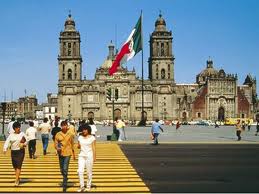
The wealth in this city goes beyond its condition of great metropolis. Its Anthropology Museum rescues the millenary memory of the whole country. In the National Palace, murals scrutinize the Mexican identity, and next to it, the entrails of the Templo Mayor indicate that this was, once, an imperial capital. Sumptuous places like the Auditorio Nacional or Bellas Artes present the best in scenic arts, and the constellation of museums protects the essence of Mexican plastic expression. Mexicas and Conquerors already knew it: this city is a treasure in itself.
The megapolis has not completely replaced the garden that saw its origins. In Xochimilco, the very famous channels and chinampas (small land areas in the shallow lake bed) still survive, as well as the very beautiful landscape that once dominated the marshy valley. Near Cumbres del Ajusco, trees cover the mountains that surround the city and you can be witness of the recuperation of species like the white-tailed deer and the volcano rabbit, or zacatuche. In Desierto de los Leones, hiking lovers will find a combination of old convents and lush forests. And all of this is available without leaving the city.
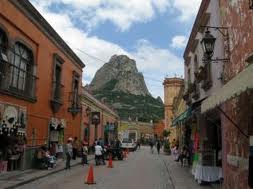 Villa de San Sebastian Bernal
Villa de San Sebastian Bernal
A place hidden in the heart of the state of Queretaro, it was founded in the 17th Century by a group of Spanish families. It stretches on the outskirts of a rock formation, one of the largest wonders in the country. At a height of 288 meters, it is said that this rock attracts strange phantasmagorical events that give the place a lot of character. There, you can visit constructions from the 18th Century and admire the religious fervor that congregates around the San Sebastian Parish, and the Animas and Santa Cruz Chapels.
From the highway that leads to the Peña de Bernal, it is impossible not to see how this rocky outcrop rises. This is the third most imposing outcrop in the world, only after Gibraltar in the United Kingdom, and Pan de Azucar in Rio de Janeiro, Brazil. It is formed by an etching of minerals – which give it the energy that many believe to be cosmic – which is why walking around its surrounding forests presents one with the possibility of finding a piece of quartz or obsidian, in addition to the evident benefit of communing with nature.
The beauty of its Colonial buildings and the color of its landscapes are sufficient for San Sebastian de Bernal to have been recognized as a Magic Town. And if this wasn’t enough, let us add the fact that every year the more devoted travelers have a celebration at the rocky outcrop during the spring equinox, with the sole purpose of recharging themselves with positive energy. Those who have more conventional religious convictions also have many chapels to choose from and the San Sebastian parish.
Peñon de Bernal is one of the great natural wonders in the country, which is why it has become one of the goals for national and international climbers who are seeking a challenge. Lovers of adventure can reach it by rock climbing or rappelling down its walls that are more than 350 meters high. One can also hike or bike along its many forest paths.
Queretaro
Well-traced streets and corners full of local color, Queretaro reminds us of the mythical Corregidora (magistrate), Josefa Ortiz de Dominguez, and the conspiracy that unraveled the war of Independence. This Colonial city invites one to visit by cable car through its emblematic neighborhoods, with grand Spanish-style and characteristic doors and gates. And in the main plazas, such as Independencia, you will find curious handicraft shops and restaurants where you can try traditional dishes such as enchiladas queretanas.
None other than the birthplace of the Independence, the house where the magistrate Doña Josefa Ortiz de Dominguez received Allende, Aldama and the Gonzalez brothers, to plan the liberation from the Spanish crown, is in Querétaro. After the conspiracy was discovered, this was also the house where the magistrate gave the call, by banging her foot three times, which made the priest Hidalgo give the famous shout of ¡Viva México! This is why the city is filled with monuments to the first woman insurgent, and also why you must visit.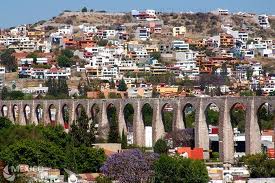
To understand why it is one of Mexico’s treasures, you only need to walk its streets. The Royal Convent of Santa Clara de Asis, and the San Felipe Neri oratory are just the beginning. If you get tired of so much history, you can set about purchasing handicrafts or have a rest and read a good book in the lovely Plaza de Armas.
San Miguel de Allende
A monument to tradition and popular art, this is the old San Miguel el Grande, known today as San Miguel de Allende. It is home to many retired foreigners and a place for wonderful hotels and delicious restaurants, antique shops and a rich cultural life that this melting pot has created.
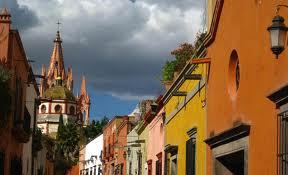 Year after year, hundreds of visitors arrive in San Miguel de Allende attracted by the national festivities, like the “Sanmiguelada”, a popular celebration inspired by the famous Spanish Pamplonada. However, in addition to bulls running free on the streets, the danger is also lurking elsewhere: the Ignacio Ramirez and handicrafts markets, where it is impossible not to walk away without a treasure made from silver, gold, brass or forged iron, products from the mine and the mastery of the best artisans.
Year after year, hundreds of visitors arrive in San Miguel de Allende attracted by the national festivities, like the “Sanmiguelada”, a popular celebration inspired by the famous Spanish Pamplonada. However, in addition to bulls running free on the streets, the danger is also lurking elsewhere: the Ignacio Ramirez and handicrafts markets, where it is impossible not to walk away without a treasure made from silver, gold, brass or forged iron, products from the mine and the mastery of the best artisans.
Being as close to Dolores as it is, San Miguel el Grande could not be left on the margins of the Independence insurgency, which is why houses and cellars stored guns and ammunitions. Many of its children, like the Aldama brothers and Ignacio Allende (who now gives the city its new name), participated in the armed struggle that eventually led Mexico to its Independence. Walking these beautiful, cobbled streets, one tries to imagine the call to freedom that rang through this picturesque town so many years ago.
With architecture representative of the Viceregal period and a cathedral in the Neo-Gothic style that frames the main plaza, San Miguel de Allende preserves its true colonial feel. UNESCO declared this tangle of streets and colonial plazas a World Heritage Site, where art and culture is perceived at all times. This is a small city with a huge heritage and a cosmopolitan population.
Guanajuato
This is the ideal city in which to get lost; among its streets which twist, cross and end in wonderful plazas full of history but also restaurants, bars, coffee shops and stores. Guanajuato was one of the richest cities during the colony and this abundance is reflected in its churches, monasteries, theaters and museums. It is also another birthplace of the Independence movement, and venue of one of the most important cultural festivals on the continent.
Guanajuato was the backdrop of one of the most important victories of the Independence movement; the taking of Alhondiga de Granaditas, which was where the governor and several Spanish families were held under siege until the heroic actions of a miner known as “El Pipila” gave insurgents the triumph. A year later, the heads of Hidalgo, Allende, Aldama and Jimenez were hung from its four corners and they remained there until 1821. Today, if one knows ones history, it is impossible to visit the city without feeling patriotic enthusiasm come alive.
This opulent Colonial city, located among gold and silver deposits, had its greatest peak in the 17th and 18th Centuries, but its splendor is not diminished. It is listed in UNESCO’s World Heritage Sites, together with the adjacent mines, because they still surprise visitors with important architecture rooted in national history. You must direct your steps towards the basilica of Nuestra Señora de Guanajuato, the Alhondiga de Granaditas, and the university because each one of these has a story to tell.
Guanajuato still keeps its traditions alive and, step after step, you walk through the city surrounded by ghosts of its legendendary past. The colonial and mining atmosphere invites the traveler to tour it in search of mummies, churches, plazas or literary alleys. The traditional coffee houses and artisan workshops seduce visitors with their tantalizing smells and sights. The city also offers festivals throughout the year, like the Cervantino and the international film festival, which can be combined with the best in Mexican gastronomy.
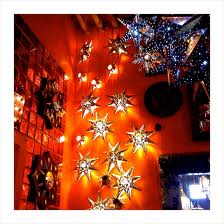 Tlaquepaque
Tlaquepaque
There is no better place in the country to buy popular art. Here, the most expert artisans exhibit their fine work in wood, silver, brass, crystal or leather. And to end a day of shopping, Tlaquepaque also offers typical restaurants, cantinas and lovely patios. It is also a Pueblo Magico in the state of Jalisco, which today is part of Guadalajara’s metropolitan area.
This is the land of Jalisco’s artisans, the origin of the famous saying “you’re like a Tlaquepaque pitcher” (referring to the breakable pottery), but this land is not fragile, it is a municipality devoted to ceramics with a long tradition that carries the clay in its very name. From the pedestrian bridge, it receives curious travelers eager to fill their shopping bags and takes them along the streets with fantastic handicraft stores stuffed with original pieces in forged metal, gold or silver work, embroidery and ceramics.
When dining in the state of Jalisco, you may find yourself remembering the Tex-Mex flavor that one finds in the good Mexican food restaurants in the USA. This is because the Jaliscans use familiar spices such as cumin and chili powder that prevail in their gastronomy and that spread through the USA at top quality restaurants started by immigrant workers seeking a new beginning.
Tequila
A charming town, where one can find a large number of tequila factories, one can observe the whole elaboration process and also have a tasting of the distilled beverage. And whether it is on a horse ride through the fields where agave is grown to contemplate Jalisco’s tequila lands, or on a tour around the Plaza de Armas in Tequila to admire the French-styled kiosk and the picturesque ambiance of its gardens, this is the ideal destination in Jalisco’s rural world.
It is rather obvious that this is the birthplace of the most representative beverage in Mexico, which is why it carries its name and boasts the denomination of origin. It also goes without saying that the best producers of this drink, previously known as “mezcal wine”, offer tastings of their best products along with information about distillation processes, which always end with some myths about the best way to drink it. Exploring this region is wonderful anytime but visitors will find a special treat in store for them if they visit between November 29 and December 13, when the Tequila Fair is held.
Under the shadow of the awe-inspiring volcano by the same name, the city of Tequila is a perfect starting point to reach its peak, only 16 kilometers away. Once at the peak, some 3,000 meters above sea level, in addition to glorious sights, you can admire flora specimens that are only found at this altitude, and the 60 different species of birds that fly the skies. The area is also visited by deer, coyotes, armadillos and other animals.
Not just the buildings are considered World Heritage Sites by UNESCO. As strange as it may seem, the agave landscape of tequila’s motherland is one of the first cultural panoramas that have been included in the list of protected sites. Naturally, the former industrial facilities in the town of Tequila were also recognized as part of this heritage. This is another reason to approach and contemplate the emblematic blue sea of magueyes that floods this region.
When the Conqueror, Cristobal de Oñate, founded the village of Tequila in 1530, he never imagined that the stone walls of the Temple of la Purisima and the metallic archangels that guard it would be witness of its designation as a Magic Town. Beyond the famous national beverage, the city enchants because of its traditions and customs, like the blessing at nine every night, when the priest steps out after three bell tolls to bless the whole town, and everyone stops their activities to rise and look in that direction.
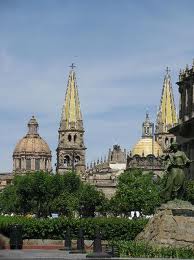 Guadalajara
Guadalajara
The land of tequila, mariachi, tortas ahogadas and jarabe tapatio, Guadalajara is also a magnificent cultural and historical center. The old area has been declared a World Heritage site. It is the venue of the largest Book Fair for the Spanish language, and land of great artists such as the muralist Jose Clemente Orozco and the architect Luis Barragan. Recently, it has undergone a fresh urban renovation, and its bars and restaurants are among the best in the country.
Founded during the Colonial period as Nueva Galicia, the capital of the state of Jalisco was the scenario for some of the outstanding events in the War for Independence. It was in Guadalajara where Allende, Abasolo and Jimenez organized their insurgent army, and where Miguel Hidalgo y Costilla declared the abolition of slavery in Mexico, punishable by death, in December 1810. One year later, Francisco Severo also published here his newspaper El despertador Americano, where Hidalgo would publish his ideas.
It is not surprising that among the architectonic profusion in Guadalajara we can find one of the only three buildings in Mexico considered to be World Heritage by UNESCO, per se. Hospicio Cabañas, by architect Manuel Tolsá, is a building in the Neoclassical style that opened its doors in 1805 as a shelter for orphans, the elderly, and other unprotected people. Since 1939 it also houses works by José Clemente Orozco, one of the country’s great muralists. Because of this and more, Jalisco’s capital is invaluable.
A good part of the iconography associated in the rest of the world with Mexico is typical of Guadalajara. Just to mention some images: tequila, mariachis, and charros. Many of the scenes from Mexican cinema’s golden age that have formed entire generations and continue to identify all of us, happened in this city, the second most important in the country and center for economic, cultural and educational development.
To book a trip through the Route 4 Region, please send us an email to; info@weareonetravel.com or fill in the Contact Form on the right hand side of this page.



